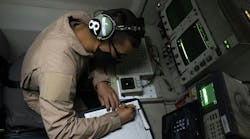To The Editor:
I am writing to comment on the article on page 1 of your February 2000 edition regarding the hard lessons PEC learned in attempting to employ NEC's 20.1-inch Liquid Crystal Display in harsh environments. I believe the article improperly leaves the impression based on one manufacturer's experience that a ruggedized 20.1-inch NEC panel cannot perform in harsh military environments. While I do not question PEC's experience with the NEC product is as stated, it is definitely not indicative of our results and successes with this product.
Specifically, BAE SYSTEMS, 20.1-inch flat-panel monitor, model number RFM201, is ruggedized and has demonstrated that it meets the harsh military environments experienced in airborne, shipboard, and ground-mobile applications. The key to successfully ruggedizing this COTS product, while at the same time mitigating the risk associated with COTS products, was our investment in a design/development process that rigorously evaluated the commercial NEC product, determined what ruggedization was necessary, and extensively tested the resulting product to validate the ruggedization design.
The most important single issue in the design was the ruggedization of the LCD substrate, not only to protect it from temperature extremes, humidity, salt fog, sand, and dust, but also from severe vibration and shock levels it will experience. Our conclusion was that the LCD substrate needs to be completely isolated from these environments.
Our solution was to develop a process that completely encapsulates the substrate between 2 panes of optically clear glass.
Our test results to the environments noted above on this design showed that this "sandwich" approach does indeed make the substrate impervious to the environment while maintaining, and in some ways enhancing, its opto-electrical performance.
Having reviewed similar products from other companies using 20.1-inch NEC LCDs, I believe they have validated similar design approaches.
In addition, we performed the 72-hour test at -40 degrees Celsius noted in the article and did not experience any of the troubles PEC encountered.
We can only conclude that the problem PEC encountered lies not in the NEC panel, but in PEC's approach to ruggedization for harsh military environments.
Regarding the article's comments that NEC specifications for the glass make it clear that the LCD is not to be used in applications that put human life at risk, I concur that this is true for their standard product. However, none of the commercial LCD panel and/or monitor manufacturer's (such as NEC, Sharp, and others) warrant their units once they have been disassembled and ruggedized, which is what all ruggedizers of displays do.
In addition, users of display devices (CRT, LCD, etc.) have long recognized that a vacuum-sealed device creates a potential hazard. That is why stringent safety tests are required before such a product is accepted for use (even development testing) on a military platform. For example, BAE SYSTEMS developed a version of its 20.1-inch flat panel monitor for the Airborne Warning and Control System (AWACS) aircraft application. Before the two test units were allowed to fly aboard an AWACS test aircraft they were required to:
- pass a Safety of flight test including explosive atmosphere, explosive decompression, acceleration, and temperature altitude; and
- be approved for flight by an AWACS Aircraft Integration Board, consisting of representatives from the U.S. Air Force and the platform integrator.
The objective of these requirements is to ensure that there is no risk to human life. Here again, the BAE Systems 20.1-inch flat-panel monitor successfully passed these hurdles and performed without failure during six months of operational flight-testing on AWACS.
In summary, BAE SYSTEMS and other companies have successfully developed 20.1-inch ruggedized flat panel monitors, using NEC's LCD product, that have been bought by military users worldwide and are today successfully performing in the specified extended environments (see page 3 of the February issue of Military & Aerospace Electronics, as an example). The 20.1-inch flat panel monitors are operational today in airborne, shipboard, submarine, and ground-mobile applications. The results speak for themselves. The 20.1-inch NEC LCD monitor, properly ruggedized, is an excellent product that meets military user requirements.
Nathaniel Rothman
Director, Business Development
Flat Panel Display Products
BAE Systems Aerospace Inc.
Advanced Systems
Rockville, Md.
DAP Technologies deserved coverage
null
To The Editor:
I read each release of your excellent Military & Aerospace Electronics magazine. In the January 2000 issue there is an obvious omission. On the front page at bottom right is a picture of two hand-held computers. In the article by J.R. Wilson it mentions many names of manufacturers of this kind of equipment.
The picture shows the Microflex CE5320 and CE5240 from DAP Technologies of Vanier, Quebec (www.daptech.com ). These units are very rugged. There is no reference in the text to the name of the unit or the manufacturer. I think they deserve it.
I am president of Groupe Uni-Spec in Chicoutimi, Quebec (www.uni-spec.com). We are a reseller of this equipment. We use this equipment in very rugged places. One example is in an aluminum production plant. We have developed a small data acquisition module that can be plugged in a Microflex PC9000 that can make millivolt measurement on a pot where aluminum is produced. The Microflex is one of the few units that can actually work in the very strong magnetic field around the pot.
In the aerospace world, Bombardier uses one of our software packages called Quali-Plus running on Microflex to evaluate many quality aspects when producing their Regional Jet line.
Benoit Verreault
president
Groupe Uni-Spec
Chicoutimi, Quebec
The AV-8B, not the F/A-18 E/F, plays the lead role in the OSCAR program
null
To The Editor:
I subscribe to Military & Aerospace Electronics because it usually is a source of leading-edge information from informed sources. It helps tremendously in the work I do for the AV-8B program here at China Lake. Therefore I am very disappointed in the front-page article of the January 2000 issue concerning the F/A-18 E/F and the PowerPC upgrade. The AV-8B is the leader of this effort. It was started in 1995 and is called OSCAR, Open Systems Core Avionics Requirement.
The project is a consortium of PMA-257, PMA-209, AV-8B JSSA (USMC, Italy, Spain), Boeing/McDonnel Douglas, GDIS, and DY 4 Systems. The project includes replacement of the AYK-14 Mission Computer and legacy Stores Managment Computer with complete redevelopment of the related software. AV-8B has flown each generation of the DY 4 PowerPC-based 6U VME product, something F/A-18 has yet to do. Everything F/A-18 has in this area is a result of the AV-8B initiative, including much of the software functionality developed between the Boeing "Boldstroke" intiative and the AV-8B OC1.1 block upgrade (one of the goals is reusable software across platforms).
Your article not only doesn't mention any of these facts, it gives the impression the F/A-18 invented this intiative. This is misleading and erodes the credibility of your publication. Besides, as you might imagine, I am very proud of the AV-8B intiative and accomplishments.
James E. Wojciehowski
AV-8B Joint Systems Support Activity
Naval Air Warfare Center, China Lake
Ridgecrest, Calif.
[email protected]
Editor's note:
We at Military & Aerospace Electronics regret any misunderstanding concerning the roles of the AV-8B Harrier jump jet and the F/A-18E/F fighter-bomber in the important role of qualifying the PowerPC microprocessor for military flight computer operations. In the past we have written about the OSCAR program and the role of the AV-8B in that program, and we recognize the importance of the AV-8B aircraft in making way for the future broad use of the PowerPC in military avionics. Ultimately we know that the AV-8B and the F/A-18 aircraft will have indispensible roles in pioneering the PowerPC for mission-critical flight computers. It was never our intent in this regard to diminish the role of the AV-8B or of the men and women who have worked so long and so dilligently on the OSCAR program.
To The Editor:
The February issue of Military & Aerospace Electronics featured an article reporting on the inability of NEC 20.1-inch active-matrix liquid crystal display (AMLCD) modules to withstand long-term storage below - 40 degrees Celsius. Computing Devices Company's display group has successfully engineered packaging solutions to the problems identified in the article, to qualify the same display module for the NATO AWACS airborne environment and for a difficult ground-mobile environment.
Proving tests on several units included 100 cycles of -55 C to 100 C excursion, as well as 72 hours storage at -55 C. No failures were encountered in any of these tests. To date, several hundred delivered units, subjected to three 4-hour cycles of -40 C to 85 C have confirmed our confidence in the robustness of the NEC module and our own engineering design.
CDC's confidence in these re-engineered commercial display products is sufficient to accept warranty liability for application in severe military environments. Confidence has been earned by implementing extensive development testing for many different ruggedised FPD products.
Details of some of CDC's engineering advances will be presented during the 2000 SPIE Aerosense Conference in Florida.
Floyd Bosko
Displays Director of Marketing
Computing Devices Canada
Ottawa, Ontario
For further details or copies of the test contact Floyd Bosko by phone at 613-596-7009, or by e-mail at [email protected].


